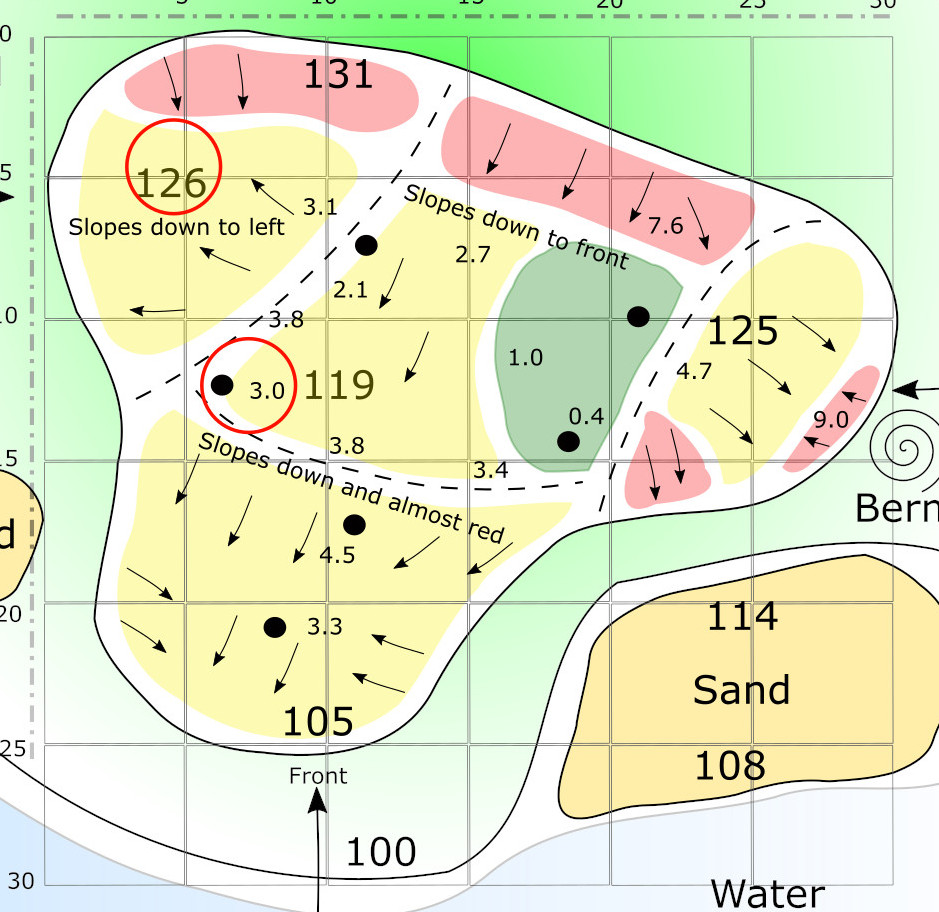Your golf scoring strategy should start during your setup on the tee. Plan all your shots as they come up, play with confidence and give yourself the chance at great scores.
Pros have been practicing for years, they work out, are in top form and regularly shoot under par. That’s not an accident.
They know how far they hit the ball and use yardage books. Here is a 4 page example from a yardage booklet that I made. (Note: The rules changed and yardage books have become pretty small for tons of detail.)
Practicing for as many situations as you can gives you an advantage. Confidence comes from practice.
Ending up in a place or position you have never hit a ball from can be a really add strokes to your score.
I’m looking at this from the perspective of someone who has played well in the past, but not for some time due to my career. Now that I’m retired I would be happy to shoot 90 for eighteen holes.

Fairways are great, greens are where you score
Tee shots
You can bet that when a pro is standing on the tee he or she is planning on a shot that lands in the fairway.
Another key would be to hit to a position in the fairway that leaves a yardage that you feel comfortable with. A yardage you are confident that you can get close from.
The other question would be “Where do I want to be if I miss?” You want to be able to have the best shot at the green if you do miss the fairway.
I try to hit the ball in the fairway. In the fairway or just off is good. It’s only the first shot.
Playing a second shot
Pros routinely end up inside of 10 feet from the hole on shots of 100 yards or closer. From farther back pros leave much longer putts. For reference, from 175 yards they usually hit the ball inside 40 feet from the hole.
This is a link to a chart on how close pros hit their approach shots for reference. (Twitter post from Lou Stanger – Golf Stat Pro)
My goal is hitting greens in regulation.

I aimed at the middle
and hit it long – red circles – Not Good
Pitching
When playing the third shot on a par 5 or when missing an approach shot, pros most likely hit it within ten feet of the hole.
That is a great goal.
I’m usually playing for a bogey. So for me, a pitch would be a second or third shot close enough to two putt. Salvaging par is a possibility.
Chipping
You can bet pros plan on holing their chip shots if they have a clean lie. The exception would be when they have a bad lie or hit out of deep rough adjacent to the green.
If they can see most of the ball, they want to hole the chip shot.
Without a doubt, they practice thousands of chip shots to be that confident.
I really do try to chip in or hit it close enough for a chance at a one putt.
Sand Shots
Have you ever heard them say on TV that they bet the pro hopes they end up in a bunker instead of long grass around the green?
They plan on holing sand shots from good lies also.
For me, it’s getting the ball close. Close enough to make a par or bogey.
Putting
Pros are pretty confident on most all putts. Typically a lag putt occurs from 30 feet or more.
For me, lag putting starts outside of 20 feet. I use the “Never up Never in” theory from 20 feet and closer. Outside of 20 feet I’m pretty happy getting the ball within 3 feet of the hole.
Many suggest that you try and lag putt to within 10 percent of the length of the putt. Examples: 30 foot putt…lag to within 3 feet, 40 foot putt…lag to within 4 feet, 50 foot putt…lag to within 5 feet.
Conclusion
I’m not a pro. Pros are confident. They pretty much know where the ball is going and how the ball is going to react on every shot.
This is my golf scoring strategy.
When I’m on the tee and hit the ball in the fairway that is… one stroke. The strategy is hit it in the fairway or leave it where I have an open shot to the green.
On approach shots, I plan on hitting the ball on the green. Getting it close to the green is the second best outcome. It is still only… one stroke… even if you miss the green.
Here is my point about practice, confidence and the average golfer. How many strokes does it take you to hole out from on the green or around they green?
That is on the green in regulation or just short of the green. (FYI – Average pro players hit 11.7 greens in regulation)
If you are two chipping, leaving the ball in a sand trap or 3 putting…that’s a problem.
Practice to improve. Practice with purpose.
My plan
How important is your short game and putting. Darn important. Practice your short game as much as you can.
While I do make pars and an occasional birdie, I usually screw up my round with a couple doubles.
Eliminating double bogeys and 3 putts makes a huge difference in your score.
I’m retired, but I’ve been trying to spend 2 hours on the range, chipping, pitching and putting. That is….when I can.
What drives me nuts is watching others practice….just up there whacking the ball. Hitting driver after driver.
Practice by hitting to a target or shots you know you are having trouble with.
Here is my routine last week. (Note: The range work, pitching and chipping was work on shots I know I will be hitting off the tee or shots I’m not as confident with as I need to be.)
Putting 20 minutes
- Putt lag putts…across the green trying to stop it on the opposite fringe just to get a feel for the green speed that day.
- Putt 10 footers – using several different holes
- 3 footers – using a putting gate
Range balls 1 hour
- 100 range balls – 7 iron, 5 iron, 4 hybrid, 5 wood and driver. Ended hitting lofted pitch shots from tight lies. (Sand trap was full of water yet from rain or I would have hit the last ten from the sand)
Chipping and pitching 30 minutes
- Chipping from 2nd cut around green – 7 iron and 8 iron downhill
- Chipping from 2nd cut around green – 7 iron and 8 iron uphill
- Pitching from 10 yards – sand wedge from intermediate rough to middle of green
Putting again for 10 minutes
- Putting breaking putts – uphill, downhill and side hill
- Putting – ended with 10 three foot putts up hill.
Notes
I pitch and chip the whole time I’m playing. By that I mean off to the side of the tee box in the longer grass.
Try to practice things you know you need to improve on.
I also putt almost every day at home.
You can buy blank yardage books and draw in detail with a pencil. Add detail over time.
This is what I did…see our page on “Mapping your course or greens.” I have a large copy 8.5 inches x 11 inches for each hole and mark it up with a pencil if I add things.
